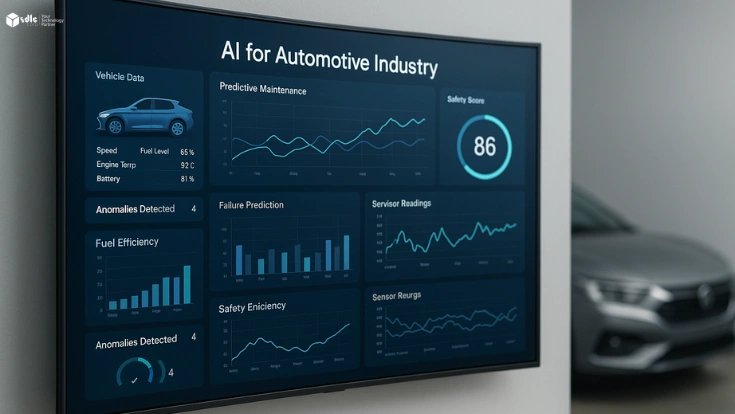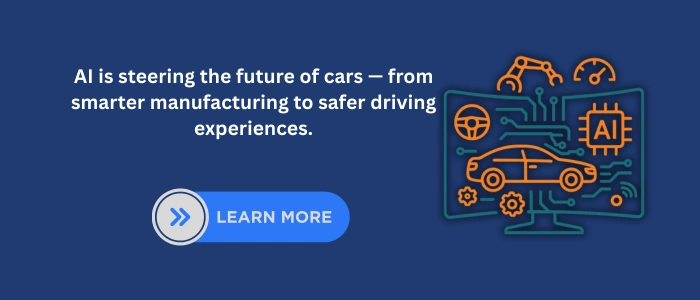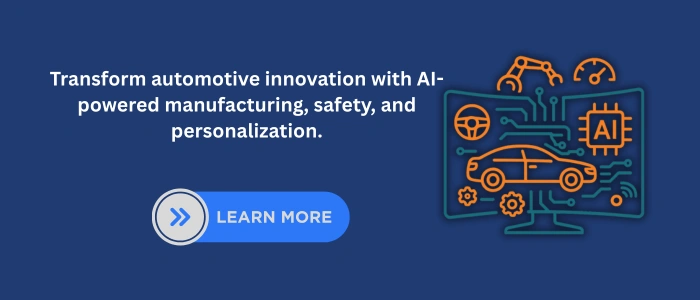Introduction
AI in automotive industry innovations are redefining how vehicles are designed, manufactured, and driven. Unlike earlier advancements that focused mainly on mechanical improvements, AI integrates data, software, and automation to create smarter and safer mobility solutions.
In design, AI accelerates prototyping by testing models virtually in hours rather than weeks. In manufacturing, AI for car manufacturing ensures higher quality through real-time monitoring, predictive maintenance in vehicles, and robotics that adapt production lines dynamically. On the road, autonomous driving algorithms process sensor data instantly to improve safety, while in-car AI personalization enhances comfort by learning driver habits.
Beyond vehicles, automotive artificial intelligence solutions are helping dealerships manage demand, insurers assess risk, and service centers speed up diagnostics. Together, these advances show why AI is no longer optional but a foundation for the future of the automotive sector.
See our insights on Generative AI for the Automotive Industry for more context.
The Role of AI in Automotive Development

AI has moved from experimental labs into mainstream automotive engineering. Its role can be seen in multiple layers.
- Design: AI tools simulate thousands of prototypes, cutting development time.
- Supply Chain: Algorithms forecast demand, track suppliers, and reduce delays.
- Safety: AI systems monitor conditions and predict failures before they occur.
Instead of replacing human judgment, AI amplifies it. Machine learning models process volumes of data faster than engineers can. Consequently, the outcome is safer cars, efficient factories, and stronger decision-making.
The transition is not about removing human expertise but about strengthening it. Moreover, engineers now have data-backed tools that enhance accuracy. Therefore, as software defines vehicles more than hardware, AI ensures that complexity remains manageable and systems stay secure.
For more, see our post on AI for Supply Chain where we detail how algorithms shorten design cycles.
AI in Manufacturing and Production
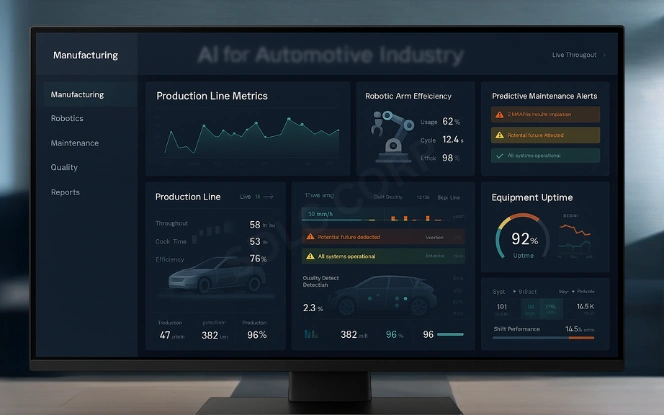
AI for car manufacturing has become a foundation of modern production. In this space, flexibility and accuracy matter most.
Key applications include:
- Predictive Maintenance in Vehicles: AI helps plants predict equipment failures before they stop production. As a result, downtime lowers and repair costs decrease.
- Dynamic Robotics: Robots guided by AI can shift tasks based on real-time needs. For instance, they adjust when materials are short or when defects are detected.
- Quality Control: AI cameras and sensors monitor every step of assembly, spotting misaligned parts or surface flaws instantly.
By combining these capabilities, manufacturers build cars faster, safer, and with fewer defects. In fact, the outcome is tangible: fewer recalls, safer vehicles, and reduced operational costs. In industries where precision defines success, AI acts as the safeguard against error.
Smart Vehicles and Autonomous Systems
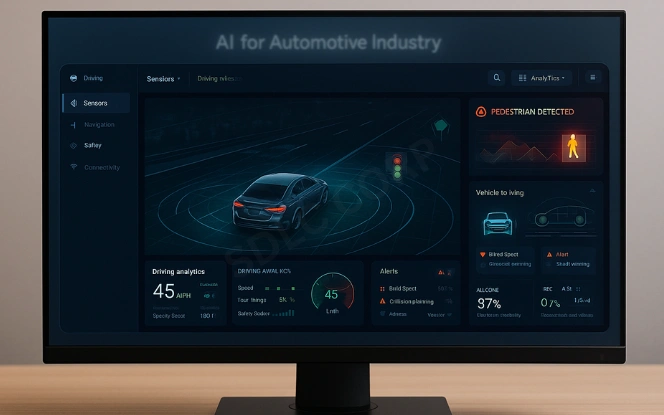
Cars today already rely on AI to improve safety. Systems like automatic braking and lane keeping are early examples of autonomy. At the core are autonomous driving algorithms that analyze radar, lidar, and camera data. Therefore, these systems decide when to brake, turn, or accelerate.
Applications include:
- Real-time road analysis: AI interprets changing road conditions and predicts pedestrian behavior.
- Driver assistance: Semi-autonomous systems reduce accidents by correcting human mistakes.
- Continuous learning: Connected vehicles upgrade through software updates, improving performance.
Another aspect is in-car AI personalization. Vehicles learn driver habits such as climate preferences, seating positions, or route choices. Over time, the system adapts, creating unique driving experiences.
Personalization also adds safety. For example, AI can monitor driver fatigue and issue alerts, ensuring safer trips. This blend of safety and convenience shows how AI brings intelligence into every journey.
Learn more about Transportation and logistics analytics and how it builds safer mobility solutions.
Automotive Artificial Intelligence Solutions for Businesses
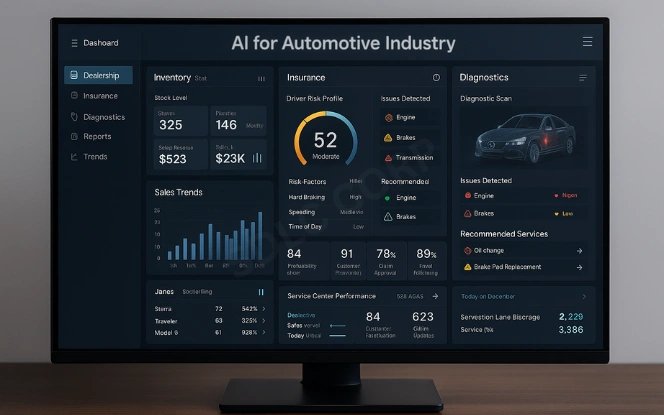
AI’s reach extends beyond cars and factories. Businesses use automotive artificial intelligence solutions to improve efficiency and customer engagement.
Examples include:
- Dealerships: Predicting demand trends to optimize inventory.
- Insurance Providers: Assessing driver behavior to build accurate policies.
- Service Centers: Diagnosing faults quickly to reduce repair time.
Connected cars generate vast streams of data. Consequently, AI organizes this information for stakeholders such as manufacturers, fleet operators, and city planners.
This results in:
- Manufacturers identifying design improvements.
- Fleet managers improving efficiency.
- Cities developing smarter infrastructure.
The value of AI extends across the ecosystem. In addition, it proves that the technology is not confined to production or vehicles but supports the entire automotive chain.
Ethical, Safety, and Regulatory Considerations
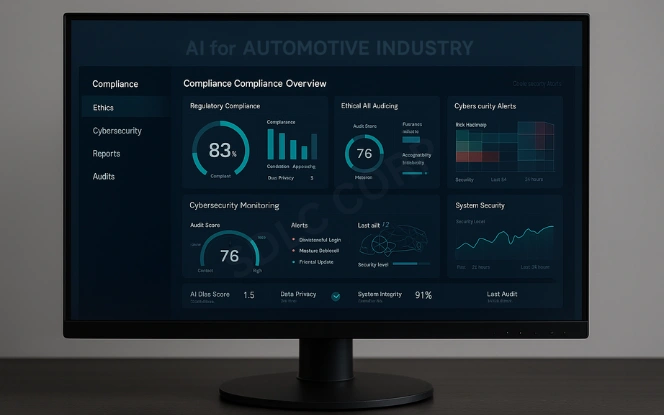
As cars become smarter, accountability becomes complex. If an autonomous car fails, who is responsible? For this reason, regulators are now working to build standards that guide ethical and safe AI usage.
Challenges include:
- Accountability: Determining liability in case of system errors.
- Cybersecurity: Cars are vulnerable to cyberattacks, making secure frameworks essential.
- Transparency: AI systems must be explainable to earn public trust.
Ethical design also requires fairness. Similarly, AI models must not favor certain drivers or regions. Safety testing is equally important, with millions of scenarios simulated before vehicles hit the road.
By ensuring transparency and explainability, manufacturers and regulators can increase adoption. Ultimately, trust will be critical for customers before they rely on AI-powered vehicles in everyday life.
Read our detailed piece on AI Ethics and Regulations for more perspectives on responsible adoption.
Future Outlook for AI in Automotive
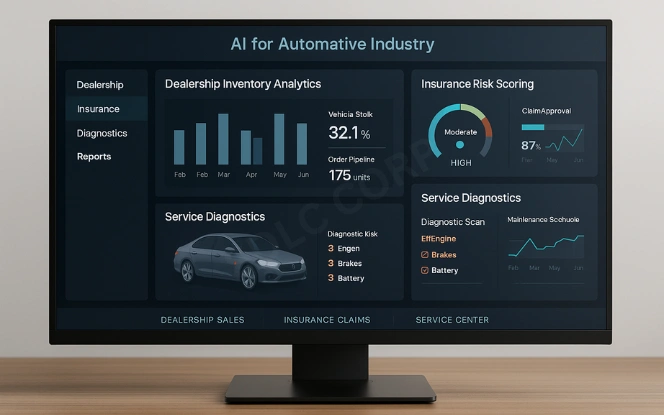
The future of AI in automotive industry operations is not defined by sudden revolutions but by steady growth.
Likely developments include:
- Smarter factories with no unplanned downtime.
- Integration with smart cities, where cars communicate with infrastructure.
- Cleaner mobility through better fuel use and electric vehicle optimization.
- Personalized travel as in-car systems adapt to user preferences.
Autonomy will develop in phases. For example, commercial fleets and delivery services will adopt advanced automation before private cars.
At the same time, AI will drive sustainability. Consequently, it will improve battery design, energy efficiency, and reduce carbon footprints. The vision is not only about autonomous driving but about creating safer, greener, and more efficient transport systems.
For more, see our forward-looking article on Top 5 AI and ML Trends Reshaping the Future.
Conclusion
Artificial intelligence has become central to the automotive industry’s progress. From AI in automotive industry innovations to AI for car manufacturing, the impact is clear. Businesses adopting automotive artificial intelligence solutions already see improvements in cost, efficiency, and product quality.
For drivers, AI delivers practical benefits. For instance, predictive maintenance in vehicles reduces the risk of sudden breakdowns. Moreover, autonomous driving algorithms improve road safety by reducing human error. At the same time, in-car AI personalization adapts to individual needs, combining convenience with enhanced safety.
The journey forward is not without challenges. However, accountability in decision-making, cybersecurity threats, and regulatory clarity must evolve alongside technology. Transparent and explainable AI will be key to building trust among consumers and regulators.
Nevertheless, the outlook is promising. Smarter factories, integration with smart cities, and cleaner mobility solutions will become standard. The automotive sector is not simply adopting AI, it is being reshaped by it. Those who embrace this transformation today will lead tomorrow’s mobility landscape.
Contact us SDLC corp to learn how AI can transform your automotive operations.
Hire AI Development Services with SDLC Corp for scalable, secure, and future-ready AI solutions tailored to your needs.
FAQs
How Is AI Used In The Automotive Industry?
AI in automotive industry applications include predictive maintenance in vehicles, autonomous driving algorithms, and in-car AI personalization. It also supports design simulations, supply chain optimization, and smart manufacturing processes.
What Are The Benefits Of AI For Car Manufacturing?
AI for car manufacturing improves production efficiency through automated quality control, robotics, and predictive systems that reduce downtime. It ensures consistent vehicle quality, lowers recall risks, and helps optimize production costs.
How Do Autonomous Driving Algorithms Work?
Autonomous driving algorithms use sensors such as cameras, radar, and lidar to process road conditions in real time. Machine learning models analyze this data to make safe driving decisions, from braking to lane changes.
What Are Automotive Artificial Intelligence Solutions For Businesses?
Automotive artificial intelligence solutions support dealerships with demand forecasting, insurers with driver risk assessment, and service centers with faster diagnostics. These tools also analyze connected car data to improve decision-making across the value chain.
How Does In-Car AI Personalization Enhance The Driving Experience?
In-car AI personalization adapts settings such as seat position, climate control, and navigation routes based on driver habits. Over time, it improves comfort and safety by detecting fatigue or distraction and offering timely alerts.

